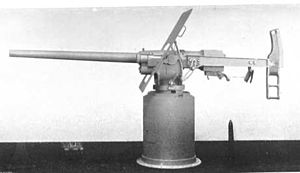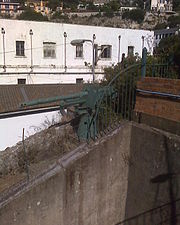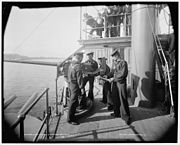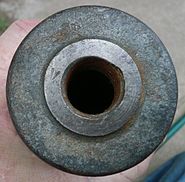| QF 6 pounder Hotchkiss | |
|---|---|
 Early Elswick gun on recoil mounting | |
| Type |
Naval gun Coast defence gun Tank gun |
| Place of origin |
|
| Service history | |
| In service | 1885 - 1940s |
| Used by |
|
| Wars |
Sino-French War, Third Anglo-Burmese War First Sino-Japanese War, Russo-Japanese War World War I Russian Civil War, Second Sino-Japanese War World War II Cod Wars |
| Production history | |
| Designer | Hotchkiss et Cie |
| Designed | 1883 |
| Produced | UE 57 Vickers medium III |
| No. built | 3,984 (UK) |
| Specifications | |
| Mass |
821-849 lb (372-385 kg) Barrel & breech[1] |
| Barrel length | various. 40-58 calibres |
|
| |
| Shell |
Fixed QF 57x307R Common and Steel Shell 6 lb (2.7 kg) 9.7 lb (4.4 kg) complete round |
| Calibre | 57-millimetre (2.244 in) |
| Breech | Vertical sliding block |
| Recoil | Hydro-spring, 4 inch |
| Rate of fire | 25 / minute[2] |
| Muzzle velocity | 1,818 feet per second (554 m/s)[3] |
| Effective firing range | 4,000 yards (3,700 m)[4] |
The QF 6 pounder Hotchkiss was a light 2.25 inch (57 mm) naval gun and coast defence gun of the late 19th century used by many countries, and was adapted for use in the early British tanks in World War I.
French History[]
|
|
This section is empty. You can help by adding to it. |
Canada History[]
These guns were used as examination guns at coastal forts in World War II, including Barrett Point battery near Prince Rupert, British Columbia
United Kingdom[]
The UK adopted a 40-calibres (i.e. 90 inch barrel) version as Ordnance QF Hotchkiss 6 pounder gun Mk I and Mk II or QF 6 pounder 8 cwt. It was manufactured under licence by the Elswick Ordnance Company.
[]
They were originally mounted for use against the new (steam-driven) torpedo boats which started to enter service in the late 1870s.

A QF 6 pounder Hotchkiss at Parson's Lodge Battery on Gibraltar
The original 1885 Mk I lacked a recoil system. The Mk II of 1890 introduced a recoil system, with a pair of recoil/recuperator cylinders.[5]
During World War I the navy required many more guns and a version with a single-tube barrel was developed to simplify manufacture, identified as "6 pdr Single Tube". Initially these guns were only allowed to be fired with a special lower charge but in 1917 they were relined with A tubes as Mk I+++ which enabled them to use the standard 6 pounder ammunition.[5]
After World War I the gun was considered obsolete for combat use, but continued in use as a saluting gun and as a sub-calibre training gun. Many were brought back into active service in World War II for arming small vessels for coastal and anti-submarine warfare, and for coastal defence. The vessels so armed included early models of the famous Fairmile D Motor Gunboats, some of which were not re-armed with the modern autoloading 6 pdr MkIIA until late 1944.[6]
United Kingdom tank service[]

The gun was used to equip Male versions of the early British tanks, Mk I - Mk III. In 1916 the British Army was faced with the difficulty of quickly providing a new class of weapon with no prior battlefield experience, and the existing Hotchkiss 6 pounder naval gun appeared to most closely meet the need. A single gun was mounted in each sponson (side barbette), i.e. 2 per Male tank (tanks armed only with machine guns were designated Female), able to fire forwards or to the side.
The gun turned out to be too long for practical use in action in side sponsons, as it could come into contact with the ground or obstacles when extended to the side as the tank travelled over uneven ground. The British chose to shorten the gun rather than change its location, and replaced it in 1917 in the Mk IV tank onwards by the shorter QF 6 pounder 6 cwt.
United Kingdom anti-aircraft service[]
Britain lacked any dedicated air defence artillery early in World War I and up to 72[7] 6 pounders were adapted to high-angle pedestal mountings at key establishments in Britain for close air defence by 1916. They are not listed as still being in service in this role at the end of the war,[8] presumably because German bombing attacks were conducted from relatively high altitudes which would have been beyond this gun's range.
United Kingdom ammunition[]
Icelandic History[]
The 57 mm Hotchkiss naval gun was used by the Icelandic Coast Guard, and served as the main gun of most of its patrol vessels between the 1920s until 1990 when it had been completely replaced with 40 mm Bofors autocannons.
US History[]

The history of the Hotchkiss six pounder (called the Rapid Fire gun rather than Quick Firer in the US) in United States Navy and Army service is apparently a complex story. It was used in conjunction with other makers design, its primary rival being the Driggs-Schroeder six pounder. Oddly, one shipbuilding and naval supply company, Cramp & Son's, had a license to build both the Hotchkiss and Driggs-Schroeder and sold both to the Navy in parallel. It appears that Hotchkiss type guns had an edge in production in the first half of the 1890s but by 1895 Driggs-Schroeders were being produce in quantity to equip a considerable number of newly commissioned ships. However, the initial purchases by the Navy were in small lots each year and there was no mass-production pf these guns like one would see in smaller weapons. Both Hotchkiss and Driggs-Schroeder guns used the same ammunition and eventually the Navy made certain that the ammunition for both was identical. There is no question that the Driggs-Schroeders were predominant in the new protected and armored cruisers that were being commissioned by 1895, however the USS Texas, a second class battleship commissioned in 1895, carried a mixed six pounder complement of ten Driggs-Schroeders and two Hotchkiss guns. The USS Maine, an armored cruiser (but really more of a battleship) exclusively carried Driggs-Schroeder six pounders although it had a mixed one pounder battery of both Driggs-Schroeder and Hotchkiss. Ships known to have carried exclusive Driggs-Schroeder six pounders are the USS Olympia, Brooklyn, New York, Columbia. Although from photographs of particular guns on the vessels in question, it appears that the Battleships Indiana BB-1, Oregon BB-3, and Iowa BB-4 carried exclusively Hotchkiss six pounders with the USS Massachusetts BB-2 carrying Driggs-Schroeders. The six pounders would start seeing general replacement by 3 in (12 pounder)RF naval guns starting around 1910.
The US Army also used the Hotchkiss six pounder. As the primary defender of coastal fortifications and harbors, the US Army had the need for lighter guns to supplement their shore batteries, of course the Army tended to be in an experimental phase like the Navy, trying and testing new weapons in an era when military budgets were expanding after decades of Congressional stinginess. It appears that the US Army and US Navy, while both using the "Mark" system, assigned their designations to different ordnance.
Russian History[]

The Russian navy tried 40, 50 and 58-calibres versions of the gun from 1904, and later transferred them to the army.[9]
Japanese History[]
The 57 mm Hotchkiss naval gun was the standard secondary or tertiary armament on most Japanese destroyers built between 1890 and 1920, and was still in service as late as the Pacific War.
Irish Service[]
A 6 pounder gun was fitted to the single Vickers Mk. D tank used by the Irish Army between 1929-1940. When the tank was scrapped in 1940 the 6 pounder gun was removed and used as an anti-tank weapon.
Surviving examples[]
- A Russian 58-calibre model on Kuivasaari island, Finland
- 45-calibre model made by Bridgeport, on Kuivasaari, Finland
See also[]
- QF 6 pounder Nordenfelt : Nordenfelt and Maxim-Nordenfelt equivalent
- List of naval guns
- List of tank main guns
Notes and references[]
- ↑ Hogg & Thurston 1972 quote 821 lb (372 kg) for the UK 40-calibres coast defence gun. DiGiulian quotes 849 lb (385 kg) for the naval gun. Weights varied according to barrel length.
- ↑ 25 rounds per minute is the figure given by Elswick Ordnance for their 40-calibres model. Quoted in Brassey's Naval Annual 1901
- ↑ 1818 ft/s in British service, with 90-inch (2.3 m) bore, using propellant of 1 lb 15 oz (0.88 kg) Q.F. black powder or 7¾ oz cordite size 5. Text Book of Gunnery, 1902, Table XII, Page 337.
- ↑ Hogg&Thurston 1972, Page 36-39 quote 7,500 yards (6,900 m) maximum for the British version. Text Book of Gunnery 1902 quotes 4,000 yards (3,700 m).
- ↑ 5.0 5.1 Hogg & Thurston 1972, Page 36-39
- ↑ See Reynolds 'MGB 658'
- ↑ Routledge 1994, Page 17
- ↑ Routledge 1994, Page 27
- ↑ Tony DiGiulian, Russian 57 mm/40, 57 mm/50 and 57 mm/58 (2.244") 6-pdr (2.72 kg) Hotchkiss guns
Bibliography[]
- Text Book of Gunnery, 1902. LONDON : PRINTED FOR HIS MAJESTY'S STATIONERY OFFICE, BY HARRISON AND SONS, ST. MARTIN'S LANE
- Tony DiGiulian, British 6-pdr / 8cwt (2.244"/40 (57 mm)) QF Marks I and II
- I.V. Hogg and L.F. Thurston, British Artillery Weapons & Ammunition 1914-1918. London: Ian Allan, 1972. ISBN 978-0-7110-0381-1
- LC Reynolds, Motor Gunboat 658. Cassell Military Paperbacks, London, 2002. ISBN 0-304-36183-6
- Brigadier N.W. Routledge, History of the Royal Regiment of Artillery. Anti-Aircraft Artillery 1914-55. London: Brassey's, 1994 ISBN 1-85753-099-3
External links[]
| Wikimedia Commons has media related to QF 6 pounder Hotchkiss. |
| |||||||||||||||||||||||||||||||||||||||||
| |||||||||||||||||||||||||||||||||||||||||
The original article can be found at QF 6-pounder Hotchkiss and the edit history here.



